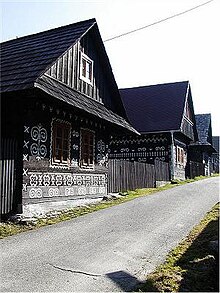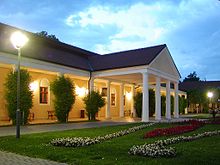Tourism in Slovakia
The Slovakia is in large parts when capital Bratislava located a few centers in the Tatras and the nearby Vienna apart an undetected by tourism country.
However, in recent years the country's tourism sector has seen strong growth. In 2014 the country was visited by almost 6 million tourists. There are a total of 7 UNESCO World Heritage Sites in the country .
In the Travel and Tourism Competitiveness Report 2017 of the World Economic Forum, Slovakia ranks 59th out of 136 countries.
Mountains
The alpine landscape of the Tatras is the main tourist attraction of Slovakia . Around the towns of Poprad and Štrbské Pleso (see Vysoké Tatry ) there are well-developed winter sports and hiking areas with opportunities for mountain climbing .
The mostly untamed rivers such as the upper Waag (Váh) offer white water rafting opportunities. Another popular form of vacation is the hunting vacation in Slovakia, as there is still almost untouched nature here. The country has nine national parks ( Tatras , Low Tatras , Pienines , Slovak Paradise , Slovak Karst , Great Fatra , Little Fatra , Poloniny , Muránska planina ) and numerous nature reserves - there are hardly any mountains that are not subject to some form of nature protection.
In addition, Slovakia is characterized by the frequent occurrence of caves. 13 caves are open to visitors, the largest of which - Demänová Freedom Cave - is almost nine kilometers long.
Spa stays
The most famous spa town in Slovakia is Piešťany in the west of the country, not far from the border with the Czech Republic. Piešťany has a long tradition as a spa. More spas are Bojnice , Brusno , Dudince , Lúčky , Sklené Teplice , Sliač , Smrdáky , Trenčianske Teplice , Turčianske Teplice , Nový Smokovec , Štós , Štrbské Pleso , Tatranské Matliare , Bardejov Spa , Číž , Nimnica , Rajecké Teplice and Vyšné Ružbachy .
Culture


The country also has numerous medieval castles and palaces to offer. Including the Spis Castle (Spissky Hrad) that the 1993 World Heritage of UNESCO counts.
But Slovakia also has a lot to offer the culturally interested visitor. Due to their location close to the border with several countries and due to the many ethnic minorities , the cities of Bratislava and Košice seem very cosmopolitan despite their small size. In addition, there is the "coffee house atmosphere" typical of the former Austro-Hungarian cities and the well-preserved old town with spectacular sights such as Bratislava Castle . But many smaller cities are also very attractive, especially since they are not yet overrun by tourists.
Infrastructure
The country is well developed by a relatively dense railway network operated by the state railway company.
The bus network is also very dense. Overall, it is considered cheap and is therefore also suitable for backpackers , for example . The motorway and expressway network , which requires a vignette , is still under construction and currently best provides access to the west and north of the country.
Slovakia is accessible through a dense network of hiking trails. In 2019 there were more than 15,000 km of marked hiking trails and almost 500 km of ski hiking trails. These are looked after by the slovenských turistov (KST) club , with the exception of the West and High Tatras, where the hiking trails are maintained by the state organization Štátne lesy TANAPu . The longest long-distance hiking trail in Slovakia is the 769 km long Cesta hrdinov SNP from the Devín Castle to the Duklapass. The International Mountain Hiking Trail Eisenach – Budapest runs through Slovakia .
See also
Web links
Individual evidence
- ↑ UNWTO 2017. World Tourism Organization, accessed August 14, 2018 .
- ^ The Travel and Tourism Competitiveness Report 2017. Retrieved February 6, 2018 .
- ↑ Značkované trasy , Klub slovenských turistov, accessed on April 27, 2020




